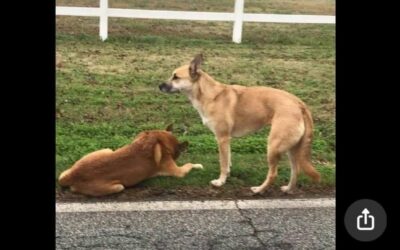A quick guide to safe essential oil use
When it comes to providing our fur-kids with relief from minor and chronic conditions, ailments, bumps, scrapes, injuries, anxiety, recuperation from veterinary procedures and surgeries, and from fleas and ticks, one of my favorite remedial therapies is the use of essential oils. Essential oils not only have powerful medicinal and relaxing, energizing, anti-microbial, and repellent properties, but also have potent and pleasurable fragrances that impact the mind and emotions making their use multifaceted and truly holistic. Filling your home and environment with their wonderful natural fragrances can purify your air and bring a quiet tranquility or positive energy to both you and your dogs.
What are Essential Oils?
Essential oils are the fragrant essence extracts from plants and fruits. Extracts can come from flowers, leaves/needles, roots, bark/resins, berries, and fruit peels. When you pick an herb from the garden and rub the leaves between your fingers, you experience the delectable aroma. Or when peeling a mandarin orange or smelling a rose blossom, those splendidly appealing aromas are the very essences that have powerful medicinal and healing effects on the body, mind, and emotions.
The extraction process and type is of vital importance to maintaining the purity and potency of the oils. Three such methods are:
- steam distillation (used for more robust plants)
- solvent extraction (required for delicate flowers)
- expression or pressed (for use with fruits and fruit peels)
It is necessary to understand that essential oils are very potent and their fragrances can be overpowering to a dog’s highly sensitive olfactory faculties. Leading expert on the canine nose, Dr. Stanley Coren, writes, “Inside the nose…are bony scroll-shaped plates, called turbinates, over which air passes. A microscopic view of this organ reveals a thick, spongy membrane that contains most of the scent-detecting cells, as well as the nerves that transport information to the brain. In humans, the area containing these odor analyzers is about one square inch, or the size of a postage stamp. If you could unfold this area in a dog, on the other hand, it may be as large as 60 square inches, or just under the size of a piece of typing paper…A dog’s brain is also specialized for identifying scents. The percentage of the dog’s brain that is devoted to analyzing smells is actually 40 times larger than that of a human! It’s been estimated that dogs can identify smells somewhere between 1,000 to 10,000 times better than nasally challenged humans can.”
In fact, if you have ever wondered why dogs’ noses are textured with all those bumps and ridges, then you will be interested to learn that it is to increase surface area to fit as many as 300 million scent receptors. Just to compare, we humans have only five million scent receptors. Thus, with a sense of smell approximately one hundred times that of a human being, it is not hard to see why the use of essential oils requires the use of caution.
Although essential oils are considered natural remedies, just as with all plants and fruit found in nature, not all are safe for dogs. Some, in fact, are toxic and may have fatal consequences. So too with essential oils, not all are safe for use with canines. And even among the safe oils, all essential oils must be used with caution. So when using essential oils either on your dog or diffused into the air, keep in mind that the oils must be sufficiently diluted and never used near your dog’s nose, eyes, or mouth.
There are several methods of essential oil use with dogs:
1) Diffused: diffusers are an excellent way to vaporize essential oils into your air. Dogs can gain great benefit from the soothing, calming, and energizing properties of many oils. Diffusers come in several capacities, but I recommend using only 1 to 5 drops per 100 ml of water.
2) Hydrosol spray or Spray mist: you can purchase a hydrosol spray which is the safest option for dogs, or dilute oils in purified water and mist onto your dog’s coat and foot pads and/or on your dog’s bedding and carpet area. If creating your own mist, be sure to have an appropriate application bottle and never spray near your dog’s face while also avoiding the throat and rump area. It is best to mist along your dog’s upper back. My recommendation is to use only a small amount of essential oil(s) in 8 oz. of water. Never use more than 25 drops if making a flea/tick/mosquito repellent even if using on bedding and carpet only.
3) Massage: adding essential oils to a shampoo or a carrier oil can offer incredible benefits when gently massaged onto
- fungal, yeast, or bacterial infections,
- minor injuries and sore muscles,
- irritated, dry, or flaky skin,
- hair loss,
- scar tissue, and more.
Massaging anxious dogs will allow them to benefit from both the touch therapy and the soothing scents of the oils. If creating a massage oil, use only 1 to 3 drops for every ounce of carrier oil. Even the smallest amount of essential oil has powerful effects.
4) Pendant diffusers: many companies have created clever pendant diffusers that can be clipped to your dog’s collar, harness, or in an area where your dog regularly sleeps. Add 1 drop of an essential oil to the pendant insert and close the diffuser. Hang the pendant on or near your dog.
5) Topical/Direct application: dilute essential oils in a carrier oil (as directed above) and apply along your dog’s spine. If you have a dog with erect or short ears, applying to the tips of the ears (known as ear tipping) can be very effective. My advice is to avoid ear tipping if you have a hound or other breed with long ears that can reach the eyes.
6) Internal: Before administering an essential oil internally, talk to a clinical aromatherapist or a certified holistic health practitioner trained in essential oils. Add one drop of an oil to a capsule filled with a carrier oil such as coconut or olive oil. If your dog tolerates the scent, you can even add 1 drop of diluted essential oil to food.
My personal favorite oils for use with canines are frankincense (my FAV!!!), lavender, chamomile, cedarwood, Cyprus, neroli, myrrh, orange, tangerine, calendula, rose, and peppermint.
The following is a list of SAFE oils that can be used on/with/for canines:
| Essential Oil | Key Action |
| Angelica Basil Bergamot Calendula Cardamom Carrot Seed Catnip Cedarwood Chamomile Cinnamon Citronella Coriander Cyprus Eucalyptus Fennel Frankincense Geranium Ginger Grapefruit Helichrysum Juniper Lavender Lemon Lemongrass Mandarin Marjoram Melissa Myrrh Neroli Nutmeg Orange Palmarosa Patchouli Peppermint Rose Rosemary Sandalwood Spikenard Spearmint Tangerine Thyme Valerian Vanilla Vetiver Yarrow | Relaxing & Stimulating, Tonic Energizing Relaxing Cleansing Relaxing Relaxing Relaxing Balancing Relaxing Energizing Cleansing Energizing Balancing Cleansing Cleansing Relaxing Balancing Energizing Energizing Cleansing Cleansing Relaxing Cleansing Cleansing Relaxing Cleansing Balancing Relaxing Relaxing Energizing Energizing Cleansing Relaxing Energizing Balancing Energizing Cleansing, Tonic Relaxing & Cleansing Energizing & Relaxing Relaxing & Cleansing Cleansing Relaxing Relaxing Relaxing Cleansing |
Use the following oils with CAUTION*:
| Tea Tree Ylang Ylang | Cleansing Relaxing |
As with anything new, exercise caution when introducing essential oils into your naturopathic health care plan. Always test each essential oil with your dog before using. To test, dilute 1 drop of essential oil in a small amount of oil and rub it onto the back of your hand. Call your dog and hold out your hand while he/she approaches you. Pet your dog on their chest, head, and between their front legs and watch your dog’s reaction. He/she may sniff your hand, show a clear interest, appear indifferent, act passive and relaxed, lick their mouth, and/or try to lick your hand. If an oil is not a good fit or is inappropriate for your dog, he/she may turn their head away, act repulsed, walk away, and even sneeze. Never force your dog to be in the presence of an oil they clearly do not like.
There are many essential oil blends that can be beneficial for physical, mental, and emotional conditions and situations. Be sure to check with a professional for combinations that are safe and effective for your dog’s needs.
©2019 Kimberly Lloyd, PhD, BCHHP, Cert Raw Dog Food Nutritionist
*Although these oils are listed on most safe lists, some dogs have had adverse reactions to Tea Tree and Ylang Ylang.



